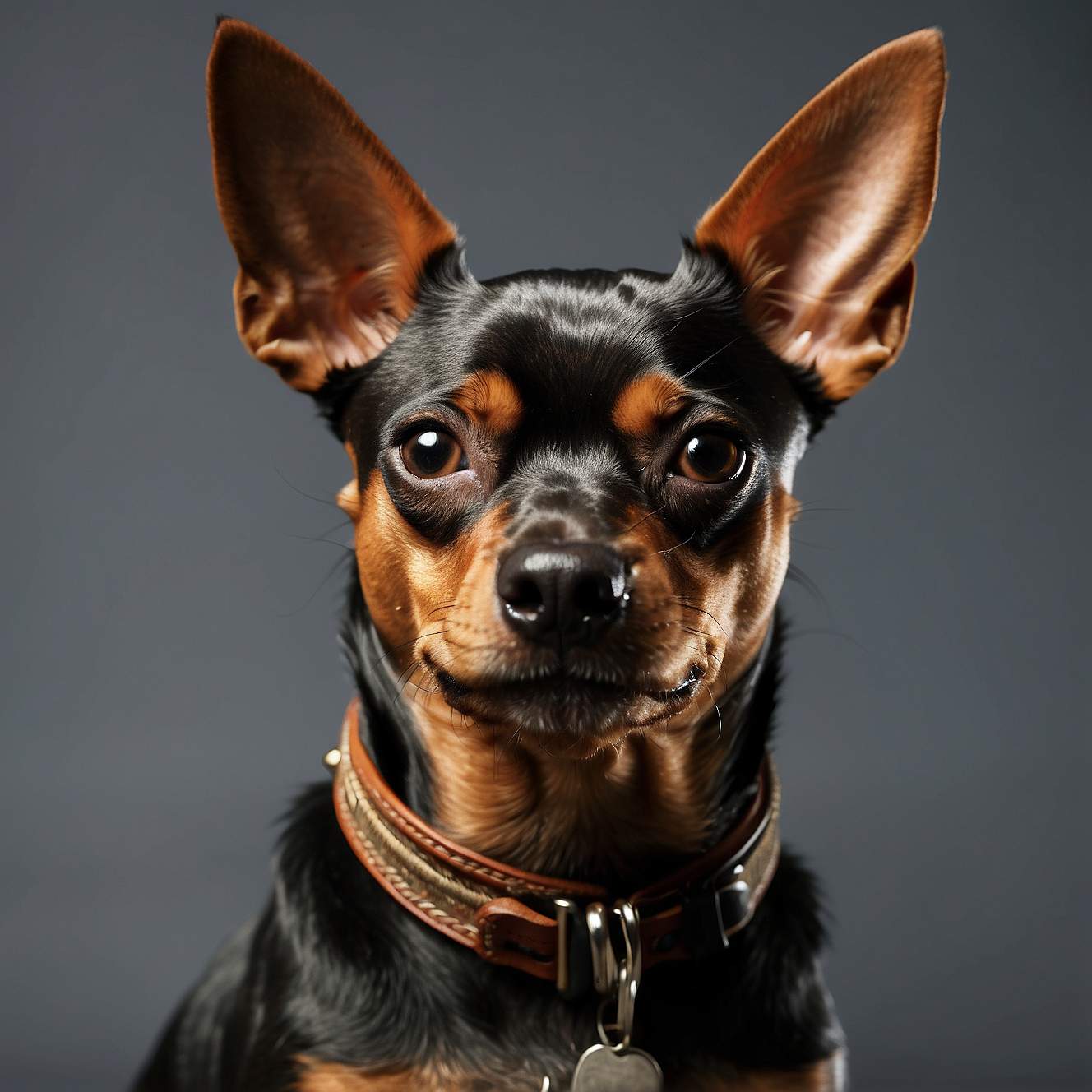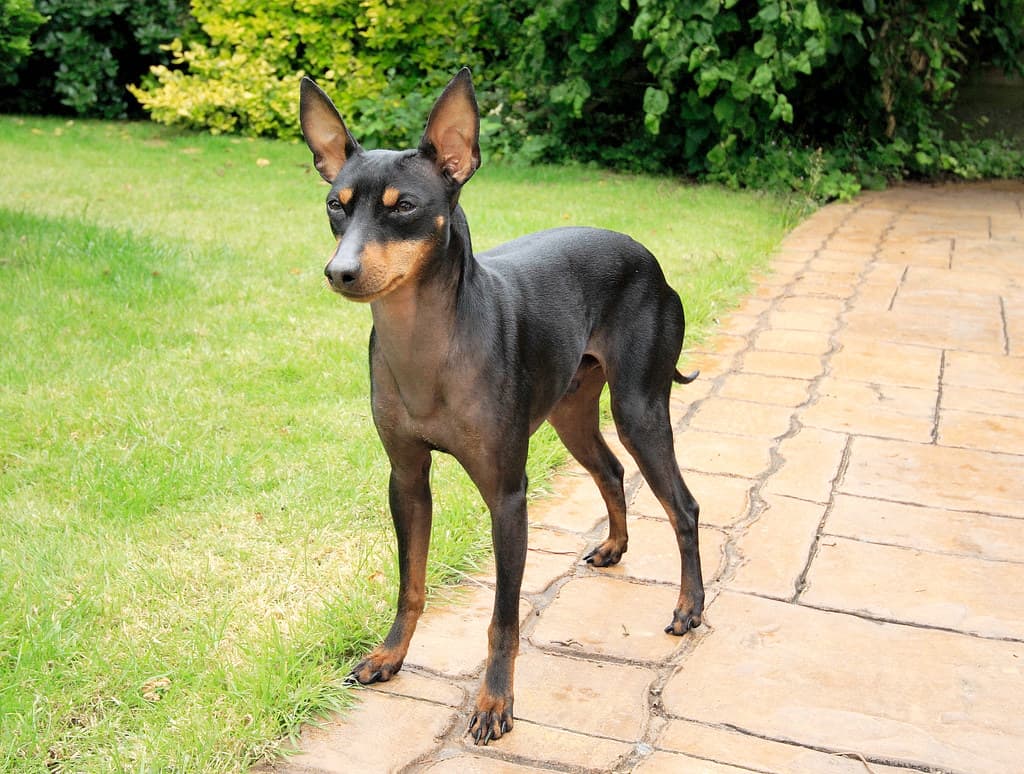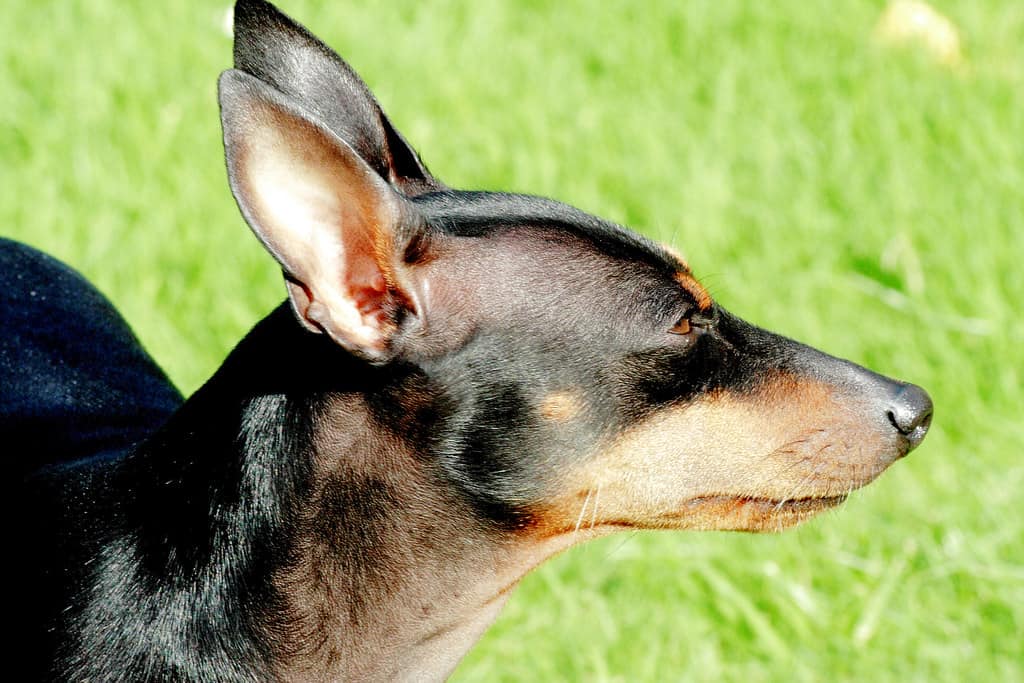The English Toy Terrier, with its sleek black and tan coat, exudes elegance and grace. Despite its small size, this breed possesses a bold and confident demeanor. A delightful companion, the English Toy Terrier is known for its intelligence, loyalty, and agility, making it a charming addition to households seeking a compact yet spirited canine friend.

| Category (Explanation) | Breed Information |
|---|---|
| Year of Breed Conception | 19th century |
| Country of Origin | England |
| Weight (lbs & kg) (Male) | 6-8 lbs (2.7-3.6 kg) |
| Weight (lbs & kg) (Female) | 6-8 lbs (2.7-3.6 kg) |
| Coat Type | Short, dense, and glossy |
| Color Variations | Black and tan |
| Shedding Level (Low, Moderate, High) | Low |
| Height (cm & in) | 10-12 inches (25-30 cm) |
| Breed Size | Toy |
| Trainability (Low, Moderate, High) | Moderate |
| Mental Needs (Low, Moderate, High) | Moderate |
| Intelligence Level (Low, Moderate, High) | High |
| Energy Level (Low, Moderate, High) | Moderate |
| Agility (Low, Moderate, High) | Moderate |
| Loyalty (Low, Moderate, High) | High |
| Playfulness (Low, Moderate, High) | High |
| Exercise Needs | Moderate exercise and playtime |
| Guarding Proficiency (Low, Moderate, High) | Low |
| Sociability with Children (Low, Moderate, High) | Moderate |
| Barking Level (Low, Moderate, High) | Moderate |
| Digging Tendency (Low, Moderate, High) | Low |
| Destructive Behavior (Low, Moderate, High) | Low |
| Drooling Level (Low, Moderate, High) | Low |
| Obedience Level (Low, Moderate, High) | Moderate |
| Apartment Friendly (Yes/No) | Yes, can adapt to apartment living with sufficient exercise |
| Inherent Prey Drive | Moderate |
| Physical Risk to Others (Low, Moderate, High) | Low |
| Travel Fatality Risk (Low, Moderate, High) | Low |
| Allergen Potential | Low |
| Health Concerns (List of Common Health Concerns) | Patellar Luxation, Legg-Calve-Perthes Disease |
| Average Life Expectancy (Life Expectancy in Years) | 12-14 years |
Woof Mastery is reader supported and our articles may contain affiliate links.
Instead of running third party ads that we have no control of we only use links from high-quality companies we are directly partnered with. Making use of these links come at no cost to you our reader, and in many cases have the extra benefit of discounted rates or sign up bonuses.
If you’re interested you can read more about our affiliate policy here.
We appreciate your support and always insure that the products and services we recommend are high-quality, helpful and relevant to the subject at hand!
The English Toy Terrier, also known as the Toy Manchester Terrier, has a history rooted in England. Developed in the 19th century through crosses between small terriers and the Whippet, it was initially used for ratting and as a fashionable companion in Victorian society. With its sleek black and tan coat, the English Toy Terrier gained popularity as a refined and elegant pet. Despite its diminutive size, this breed retains the spirit and agility of its terrier ancestors, making it a delightful and lively companion.

The English Toy Terrier stands out with its sleek black and tan coat and refined appearance. Despite its diminutive size, this breed embodies elegance and spirit. What makes it special is its agility and spirited nature. The English Toy Terrier retains the energy and charm of its terrier ancestors, making it a lively and engaging companion. Its unique blend of style and playfulness sets it apart, making it a special addition to households seeking a small yet dynamic canine friend.
The English Toy Terrier’s traditional role began in 19th-century England, where it was developed for ratting and as a fashionable companion in Victorian society. Despite its diminutive size, this terrier was valued for its agility and keen hunting instincts. The English Toy Terrier’s sleek appearance and spirited nature made it a favorite among the upper class. Today, it continues its traditional role as an elegant and lively companion, showcasing its terrier heritage in a smaller package, delighting families with its playful demeanor and distinctive black and tan coat.
English Toy Terriers are characterized by their sleek appearance and spirited personalities. Despite their small size, they possess agility and energy. These terriers are known for their affectionate nature and are often described as charming and lively. English Toy Terriers enjoy engaging in play and forming close bonds with their families. They can be intelligent and responsive to training, making them adaptable companions. With their elegant demeanor and playful spirit, they bring joy and companionship to households, showcasing a delightful mix of style and affection.
English Toy Terriers are known for their spirited and lively temperament. Despite their small size, they can display confidence and boldness. Early training and socialization are crucial to manage any potential stubbornness. They form close bonds with their families and can be affectionate companions. Due to their energy levels, regular exercise is important. While they may be reserved with strangers, they can become social with proper introductions. English Toy Terriers may not always get along with other dogs, emphasizing the need for careful introductions. With consistent training and positive reinforcement, they develop into loving and lively companions.
English Toy Terriers are small, elegant dogs with a compact and well-proportioned build. They have a narrow, wedge-shaped head with a distinct stop and a short, fine muzzle. Their eyes are dark and alert, and their ears are small and naturally erect. The breed has a sleek coat that is black and tan, with a glossy sheen. English Toy Terriers have a straight back, a high-set tail, and a brisk, confident gait. Despite their small size, they convey a sense of agility, grace, and style.
English Toy Terriers are known for their classic black and tan coloration, contributing to their elegant and distinguished appearance. The breed’s coat is characterized by a black base with tan markings in specific areas, creating a sharp and well-defined contrast. This color variation enhances the breed’s sleek and sophisticated look, emphasizing their small yet stylish stature.
English Toy Terriers have a distinctive black and tan coat, and their coat pattern is relatively uniform across individuals. The breed’s coat is short, smooth, and glossy, with well-defined markings. The body is primarily black, with tan markings on the legs, chest, and face. The tan markings often appear above the eyes, on the cheeks, and on the lower part of the legs. English Toy Terriers have a consistent coat pattern, and their elegant and refined appearance makes them easily recognizable.
English Toy Terriers have a low shedding level. Their short, smooth coat sheds minimally, and regular grooming helps maintain coat health. Brushing the coat once or twice a week removes loose fur and keeps the coat shiny. While English Toy Terriers are not heavy shedders, consistent grooming practices are beneficial for their overall well-being.
English Toy Terriers have short, smooth coats that are relatively low-maintenance. Grooming practices for this breed include:
Brushing: Regular brushing with a soft bristle brush helps remove loose hair and keeps their coat shiny. This can be done about once or twice a week.
Bathing: English Toy Terriers typically do not require frequent baths. Bathing them as needed, using a mild dog shampoo, is sufficient to keep them clean.
Ears: Check and clean their ears regularly to prevent wax buildup or infections. Use a damp cotton ball or a veterinarian-recommended ear cleaning solution.
Nails: Keep their nails trimmed to a comfortable length to prevent discomfort and maintain proper foot health.
Teeth: Dental hygiene is important. Brush their teeth regularly with a dog-friendly toothbrush and toothpaste. Dental chews or toys can also aid in maintaining oral health.
Eye Care: Keep an eye on their eyes for signs of irritation or discharge. If necessary, use a damp cloth to clean around the eye area.
English Toy Terriers have a moderate activity level. Despite their small size, they are energetic and enjoy playtime. Daily walks and interactive toys can help meet their exercise needs. English Toy Terriers also benefit from mental stimulation through training sessions and puzzle toys. While they are not excessively hyperactive, providing opportunities for both physical and mental engagement is essential for their well-being.
English Toy Terriers display intelligence in a compact package. Their small size doesn’t diminish their quick learning abilities and adaptability. They respond well to positive training methods, and their charming disposition adds a delightful touch to their intelligence. Mental stimulation and interactive play are essential to keep their minds engaged.
English Toy Terriers require mental stimulation to keep them engaged. Engage them in activities like puzzle toys, interactive games, and obedience training to prevent boredom.
Social Interaction: They are social dogs and need regular interaction with their family. Loneliness can lead to anxiety, so provide companionship and attention.
Exercise: While they are small, regular physical activity is important for their overall well-being. Daily walks and playtime contribute to their mental and physical health.
Enter The Woof Mastery

Before bringing an English Toy Terrier into your home, consider the following:
English Toy Terriers, being small in size, generally pose a lower physical risk to others. However, like any dog, they may exhibit behavioral issues if not properly socialized and trained. Early socialization and positive reinforcement training are essential to ensure they interact well with people and other animals.
English Toy Terriers, being small in size, are generally well-suited for families with children. Supervision is important, especially with very young children, to ensure gentle interactions. Early socialization is crucial to shape their behavior around kids. They can be affectionate and form strong bonds with children, making them suitable companions for families.
English Toy Terriers, being small in size, may not be natural swimmers. Their small build and short legs may limit their swimming abilities. If you wish to introduce them to water, do so gradually and in a controlled environment. Always prioritize safety and use a canine life vest if needed.
Remember that English Toy Terrier (Black & Tan) puppies, like all puppies, are eager to please and learn. Positive and consistent training practices will help them become well-behaved, obedient, and happy adult dogs. Building a strong and trusting bond with your puppy through training is a rewarding experience for both you and your canine companion.
English Toy Terriers are generally not considered excessive barkers. They are alert and may bark in response to unfamiliar sounds or activities. Early training and socialization can help establish good behavior, including appropriate barking.
English Toy Terriers adapt well to apartment living or houses with yards. They need regular play and exercise to stay healthy. Socialization is important to prevent shyness or aggression. Positive reinforcement training is effective in shaping their behavior. Owners should provide mental stimulation through interactive play and toys.
When traveling with English Toy Terriers, their small size should be taken into account. Use a secure and well-ventilated carrier for their safety. Protect them from extreme temperatures, and avoid leaving them unattended in hot conditions. Provide frequent breaks and opportunities for relief. Secure them appropriately in a vehicle to prevent injuries. If flying, choose an airline with policies suitable for small breeds and ensure compliance with crate requirements for air travel.
English Toy Terriers may be susceptible to specific health concerns. While not all individuals will experience these issues, it’s important for owners to be aware of potential health problems and collaborate with veterinarians to maintain their pets’ well-being. Common health concerns in English Toy Terriers include:
Regular veterinary check-ups, a balanced diet, dental care, and responsible breeding practices can contribute to the overall well-being of English Toy Terriers. Owners should be proactive in monitoring their pets’ health and seeking veterinary attention if any concerns arise.
Proper nutrition is crucial for the health and well-being of English Toy Terriers . Here are some nutritional habits and best practices to consider for this breed:
Breed-Specific Laws (BSL): English Toy Terriers may be subject to breed-specific laws (BSL) in certain areas. These laws are often enacted at the local or municipal level and can vary widely from one jurisdiction to another.
Types of Restrictions: The specific restrictions imposed on English Toy Terriers under BSL can include mandatory spaying/neutering, special licensing, liability insurance requirements, muzzling in public, and, in some cases, bans on ownership. The severity of these restrictions depends on local regulations.
Rationale for BSL: BSL is typically implemented based on concerns about public safety and perceived risks associated with specific breeds, often due to incidents involving dog attacks. While English Toy Terriers are not inherently aggressive, they can be affected by BSL due to their physical resemblance to breeds that are sometimes included in these laws.
Controversy: It’s important to note that BSL is a controversial topic. Critics argue that it unfairly targets breeds rather than addressing individual dog behavior and that responsible ownership and training should be emphasized instead of breed-specific restrictions.
Local Regulations: To determine if there are breed-specific laws or restrictions regarding English Toy Terriers in your area, you should check with your local animal control or government authorities. Be aware of and comply with any local regulations to ensure that you are in compliance with the law while owning an English Toy Terrier.
Woof Mastery is reader supported and our articles may contain affiliate links.
Instead of running third party ads that we have no control of we only use links from high-quality companies we are directly partnered with. Making use of these links come at no cost to you our reader, and in many cases have the extra benefit of discounted rates or sign up bonuses.
If you’re interested you can read more about our affiliate policy here.
We appreciate your support and always insure that the products and services we recommend are high-quality, helpful and relevant to the subject at hand!
Myth 1: English Toy Terriers are Fragile and Delicate
Myth 2: They are Not Good with Children
Myth 3: They are Not Suitable for Active Lifestyles
Myth 4: They are High-Maintenance in Grooming
Myth 5: They are Not Intelligent
Myth 6: They are Not Good with Other Pets
Myth 7: They are Always Anxious
Myth 8: They are Not Suitable for Families
Myth 9: They Don’t Need Exercise
Myth 10: They are Not Good Watchdogs
Understanding the characteristics and care needs of English Toy Terriers dispels myths and ensures that these small dogs can thrive as loving companions in various households.
Famous English Toy Terrier examples are not as widely documented, but these elegant and spirited dogs can be found as cherished companions in homes where their small size and lively personality are appreciated.
The English Toy Terrier, also known as the Black and Tan Terrier, is culturally significant as a breed with a refined appearance and lively personality. Recognized for their sleek coat and elegant build, English Toy Terriers have become valued as companions. Their presence in popular media and historical association with royalty contribute to their cultural appeal. English Toy Terriers are symbols of grace and charm, finding a place in the hearts of those who appreciate their unique qualities.
The English Toy Terrier, also known as the Black and Tan, gained popularity in the 19th century. While there may not be a single most famous historical owner, English Toy Terriers were favored for their small size and elegant appearance.
English Toy Terriers, like many small breeds, face specific challenges and considerations. Some of the notable challenges include:
The English Toy Terrier, also known as the Black & Tan Terrier, is a toy breed developed in England. Contributing breeds may include:
English Toy Terriers, with their small size and big personality, make delightful additions to any household. Their affectionate and lively nature brings joy to families, and their adaptability allows them to thrive in various living environments. Despite their diminutive stature, they possess a confident and playful demeanor. Engaging in interactive play and providing them with the attention they crave strengthens the unique bond they share with their families, making them treasured companions in both urban and suburban settings.